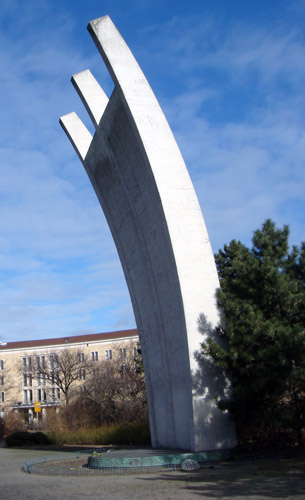![]()
There are many different ways to study the Cold War, and there are several ways that historians have periodized it (that means breaking it up into smaller stages for closer study). There is nothing especially scientific--especially since I use a lot of funerals to mark the end of stages--about this, but I would suggest this periodization.
- World War II to the death of President Franklin Roosevelt (April 1945)
- from the death of President Roosevelt to the death of Stalin (March 1953)
- from the death of Stalin to the ouster of Nikita Khrushchev (October 1964)
- from the ouster of Khrushchev to the death of Leonid Brezhnev (November 1982)
- from the death of Brezhnev until the dissolution of the Soviet Union (December 1991)
- etc
(1) Throughout the war, right up to the death of President Roosevelt, the over riding concern of the United States and the Soviet Union (the unlikeliest of allies) was the defeat of Nazi Germany. (OK, you might argue that for the US the defeat of Japan was important while that was not on Stalin's radar.) At times, some minor issues, such as Lend Lease, troubled the alliance, but both Churchill and Roosevelt kept their focus on the big picture, the defeat of Germany, Italy and Japan.
(2) We could call this phase "the-almost-shooting-cold-war." There were some pretty significant flash points that almost led to a direct war between the Soviet Union and the United States, such as Berlin (1948-49) and Korea (1950-53).
(3) As Nikita Khrushchev emerged as the leader in the USSR after Stalin, and although he still could engage in communist bluster with the best of them (kind of saying things on occasion such as "we will bury you"), and although the world could come close to nuclear war (Cuba, 1962), I still call this an era of peaceful coexistence. Khrushchev's change in theoretical emphasis from the inevitability of war to the possibility of peaceful coexistence and Khrushchev's de-Stalinization campaign marked a major shift in relations between East and West.
(4) During this period, the focus of the Cold War shifted to the developing world in Asia, Africa and Latin America. There were battles between the forces of communism and democracy around the globe as East and West battled for global supremacy through local proxies. Note the especially interesting parallel in experiences between the United States in Vietnam in the 1960s and the Soviet Union in Afghanistan in the 1980s.
(5) This was a period of an unbelievable massive arms buildup on the part of the United States, and not quite matched by the Soviet Union. This made the Cold War pretty much unwinnable, although both sides would claim victory.
(6) Though many commentators have written about the end of the Cold War, that remains to be seen. I still see a pretty much complete lack of cooperation between Russian and the United States on world issues, such as peace in the Near East, issues in Eastern and Central Europe, energy policy, terrorism, etc.
